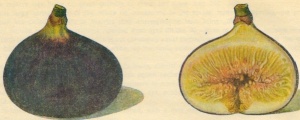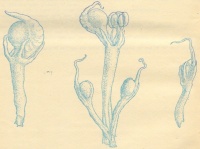Black fig
The black fig, named after the colour of its fruits, deserves special attention among all the other valuable sorts.
It has the peculiarity of a prolonged vegetation because of why it thrives well in Kakhetia only in warm locations, principally in the Transalazan district and in the low and middle Kakhetia.
It is much more requisitive to environment than the White fig,what accounts for its lesser distribution.
Tree
The tree of the Black fig grows well and produces much, especially on carbonate alluvial deep, rich soils.
Growth is vigorous, top large, spreading, dense; branches sinuous intricate, what augments still more the density of the top; mature trees have them drooping so much as to lay on the ground, what has to be taken into consideration in commercial plantations.
Durability good; the tree lives 50-60 years and produces abundantly.
Leaf polymorph, large, tree – or fivelobed, sometimes entire, petiole long, veins large, pulp coarse, uneven, fleshy.
Fruit
The Black fig yields two series of fruits yearly, spring, fruits, profigs, caprified, and summer fruits, corresponding to mammons, uncaprified.
The blossom clusters of the spring Cuda fruits mostly contain normal female flowers, on the basis of which, later on, sometimes develop male flowers with two pollen sacks.
During years with favorable climatic conditions the male flowers develop successfully and attain maturity just when female flowers are ready for the reception of pollen, and so partial selffertilization takes place; it does not warrant though the normal development of pericarps, which become soft and juicy only locally, and consequently the fruit not perfectly edible. Normal ripening and edibility are exceptions.
As to the character of the blossom cluster and fertilization, the spring fruits are real caprifigs, requiring as such crosspollination – caprification, otherwise all of them drop.
The fruits of the second crop set in Juni on the shoots of present season growth and in the axils of stem of spring fruits, at that time sufficiently large. After the 10-15 August the second crop fruits grow quickly and at the end of August begin to ripen without caprification.
According to Eisen’s classification this sort belongs to the „Adriatic type“.
Ripe fruits of the second crop are very well adapted for drying, especially if deprived of the skin.
The summer fruit of the Black fig is large, fiattened, somewhat onesided, 6,0-6,4 cm. in size.
Skin very thin, when fully ripe readily, separating from the pulp, covered with bloom.
Colour dark-blue, tinted black, veined violet.
Neck very short, but the stem thicker and longer than of the White fig fruit.
Interior of the fruit greenish-reddish-yellow, very juicy, rich in seeds, which are fertile only at a low rate.
Flavour very good.
The Black fig, thanks to its heavy productivity and the high quality of its summer fruits, has to be considered as the leading sort low Kakhetia and the Transalazan district.
source
საქართველოს კულტურული ფლორის ატლასი = Атлас культурной флоры Грузии = Atlas for the cultivated Flora of Georgia / ნ. ხომეზურიშვილი და ელ. ერისთავი ; საქართველოს სსრ მიწსახკომი. ლ.პ. ბერიას სახელ. სას.-სამ. ინსტიტუტი. - თბილისი : ტექნიკა და შრომა, 1939-1951. - 30 სმ[MFN: 51572] თემატიკა: - საქართველოს კულტურული ფლორის ატლასები; ტ. 2 : საქართველოს სამრეწველო ხილის ჯიშები = Промышленные сорта плодов Грузии = Varietes of commercial Georgian Fruits. - 1941. - 217, LIV გვ. : ილ., 71 ჩართ. ფურც. ფერ. ილ.. - დამატებითი თავფურცელი რუსულ, ინგლისურ ენებზე. - ტექსტი ქართულ, რუსულ, ინგლისურ ენებზე. - 73მ., ყდა 7მ., 2500ც.[MFN: 52879] UDC: 634.1/7:631.526.32 თემატიკა: - ხილის ჯიშები საქართველოში;

